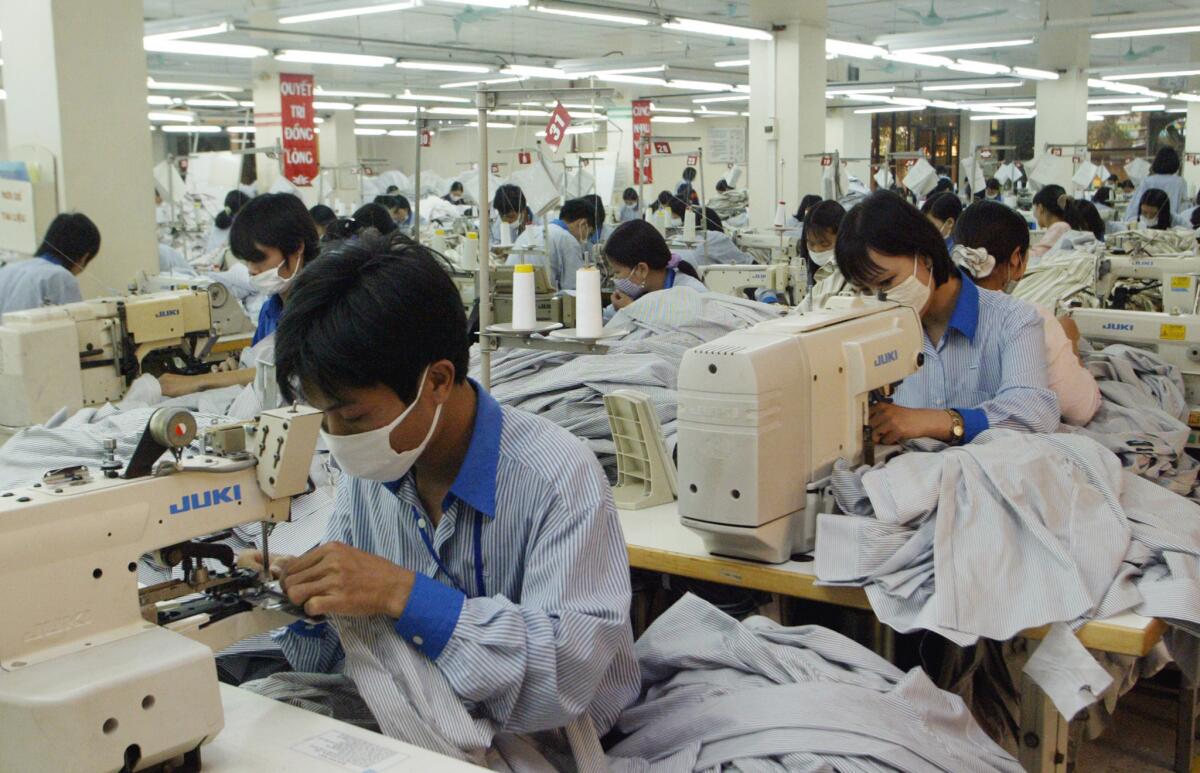Editorial: If a $15 minimum wage brings California more work robots, is that a bad thing?

Workers sew shirts to be exported to the United States at Garment Company 10 outside Hanoi, Vietnam in 2007.
- Share via
After Gov. Jerry Brown announced a proposal this week to ratchet up the state’s minimum wage 50% by 2022, business groups warned that the rapid increase could actually hurt the people Brown was trying to help. In addition to laying off workers and moving jobs out of state, they predicted, companies would move more aggressively to automate, replacing at least some of the people on their payroll with machines. That’s not an idle threat, especially for low-skilled labor; the number of tasks that computerized devices can perform at least as well as humans grows every year. But automation isn’t necessarily bad for workers — just look at what’s happening in the U.S. garment industry.
Competition from Bangladesh, Vietnam and other low-wage countries has been devastating to U.S. apparel jobs, as many domestic manufacturers have moved their factories overseas to slash their labor costs. Total U.S. employment dropped more than 80% over the last two and a half decades, plummeting from just under 1 million garment workers in 1990 to about 135,000 in February.
One consequence is that there are far fewer Americans capable of filling the available jobs than there used to be. And with sewing-machine operators making just $10.50 an hour on average, other fields are proving more attractive to young workers. The labor shortage has opened the door for companies such as SoftWear Automation, which makes what amounts to a robot brain that enables an industrial sewing machine to stitch complex seams automatically. Chief Executive K.P. Reddy says his customers are using the technology not to replace people with machines, but to increase the productivity of a shrinking pool of skilled workers and eliminate the bottlenecks created by difficult stitching tasks. That can help increase workers’ output — and their value.
Apparel makers are also using technology to make it cost-effective to start a factory in the United States, albeit with much smaller workforces than before. Machines have been making simple garments such as T-shirts for years, and as their ability to handle different materials and perform intricate stitching has improved, they’ve moved on to more complicated products such as dress shirts and jackets. These production lines still need workers, but with different skills — the new machines need to be programmed and monitored carefully, not simply plugged in and loaded with fabric.
To the extent that technology brings apparel jobs back to the U.S., that would be a win for workers. It’s better to have factories with fewer jobs than no factories at all. But the larger trend illustrated by the garment industry is unmistakable. Automation is inexorably cutting the number of people required to produce goods and changing the nature of the work involved in making them. The challenge is to equip workers here to make that shift.
Follow the Opinion section on Twitter @latimesopinion and Facebook
More to Read
A cure for the common opinion
Get thought-provoking perspectives with our weekly newsletter.
You may occasionally receive promotional content from the Los Angeles Times.









